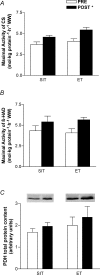Similar metabolic adaptations during exercise after low volume sprint interval and traditional endurance training in humans
- PMID: 17991697
- PMCID: PMC2375551
- DOI: 10.1113/jphysiol.2007.142109
Similar metabolic adaptations during exercise after low volume sprint interval and traditional endurance training in humans
Abstract
Low-volume 'sprint' interval training (SIT) stimulates rapid improvements in muscle oxidative capacity that are comparable to levels reached following traditional endurance training (ET) but no study has examined metabolic adaptations during exercise after these different training strategies. We hypothesized that SIT and ET would induce similar adaptations in markers of skeletal muscle carbohydrate (CHO) and lipid metabolism and metabolic control during exercise despite large differences in training volume and time commitment. Active but untrained subjects (23 +/- 1 years) performed a constant-load cycling challenge (1 h at 65% of peak oxygen uptake (.VO(2peak)) before and after 6 weeks of either SIT or ET (n = 5 men and 5 women per group). SIT consisted of four to six repeats of a 30 s 'all out' Wingate Test (mean power output approximately 500 W) with 4.5 min recovery between repeats, 3 days per week. ET consisted of 40-60 min of continuous cycling at a workload that elicited approximately 65% (mean power output approximately 150 W) per day, 5 days per week. Weekly time commitment (approximately 1.5 versus approximately 4.5 h) and total training volume (approximately 225 versus approximately 2250 kJ week(-1)) were substantially lower in SIT versus ET. Despite these differences, both protocols induced similar increases (P < 0.05) in mitochondrial markers for skeletal muscle CHO (pyruvate dehydrogenase E1alpha protein content) and lipid oxidation (3-hydroxyacyl CoA dehydrogenase maximal activity) and protein content of peroxisome proliferator-activated receptor-gamma coactivator-1alpha. Glycogen and phosphocreatine utilization during exercise were reduced after training, and calculated rates of whole-body CHO and lipid oxidation were decreased and increased, respectively, with no differences between groups (all main effects, P < 0.05). Given the markedly lower training volume in the SIT group, these data suggest that high-intensity interval training is a time-efficient strategy to increase skeletal muscle oxidative capacity and induce specific metabolic adaptations during exercise that are comparable to traditional ET.
Figures





Comment in
-
Specificity of training adaptation: time for a rethink?J Physiol. 2008 Jan 1;586(1):1-2. doi: 10.1113/jphysiol.2007.147397. J Physiol. 2008. PMID: 18167367 Free PMC article. No abstract available.
References
-
- American College of Sports Medicine Position Stand. The recommended quantity and quality of exercise for developing and maintaining cardiorespiratory and muscular fitness, and flexibility in healthy adults. Med Sci Sports Exerc. 1998;30:975–991. - PubMed
-
- Baar K. Training for endurance and strength: lessons from cell signaling. Med Sci Sports Exerc. 2006;38:1939–1944. - PubMed
-
- Barnett C, Carey M, Proietto J, Cerin E, Febbraio MA, Jenkins D. Muscle metabolism during sprint exercise in man: influence of sprint training. J Sci Med Sport. 2004;7:314–322. - PubMed
-
- Bergström J. Percutaneous needle biopsy of skeletal muscle in physiological and clinical research. Scand J Clin Lab Invest. 1975;35:609–616. - PubMed
-
- Bradford MM. A rapid and sensitive method for the quantitation of microgram quantities of protein utilizing the principle of protein-dye binding. Anal Biochem. 1976;72:248–254. - PubMed

